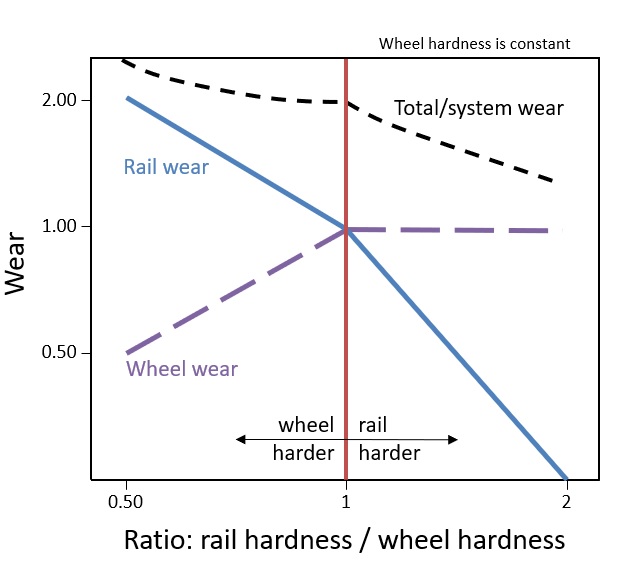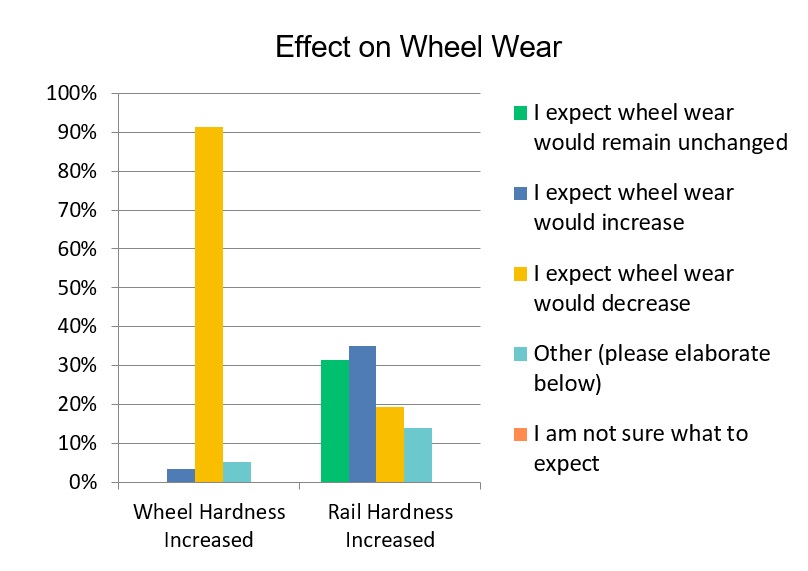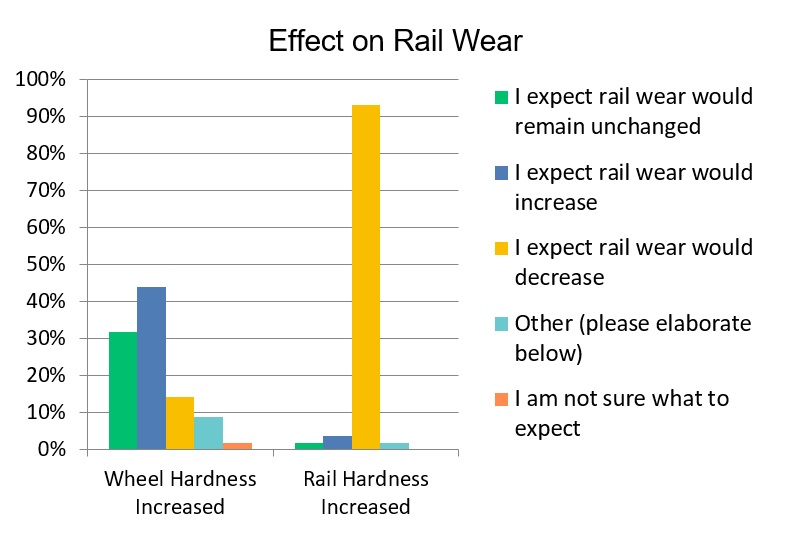Steel Hardness and Wear at the Wheel/Rail Interface: Perception vs Reality
By Jeff Tuzik
Railroads around the world have many standards for wheel and rail hardness, with varied theories regarding the interaction of harder and softer steels. And while it is intuitively apparent that harder materials should wear less, last longer and generally provide a net benefit to systemic resilience, the details and implications of this are not as clear. Many studies have examined wheel/rail interaction through the lens of material hardness, but these findings are not necessarily common knowledge in the industry. At the 2022 Wheel/Rail Interaction conference, Richard Stock, Global Head of Rail Solutions, Plasser American / Plasser & Theurer, reviewed past research and presented contemporary conclusions on wheel/rail hardness and its relation to wear and fatigue.

Hardness is a measure of resistance to localized plastic deformation induced by mechanical indentation or abrasion — it’s a relative measure. Given two partners, a wheel and a rail, one will always be harder than the other. But this relative hardness can change depending on the wheel and rail standards a given system uses, said Stock.
In Europe, rail steels typically range in hardness from 260 to 440 brinnell hardness (HB), while wheel grades range in hardness from 225 HB to 255 HB; this means that the wheel is always the softer partner in the wheel/rail interface. This is not the case in North America, where depending on the operating environment, sometimes the wheel is harder, and sometimes the rail is harder.
Wheel/rail interaction induces wear. There are several modes of wear: adhesive wear, abrasive wear, fatigue wear, and corrosive wear, and all these modes are present at the wheel/rail interface, Stock said.
Over the years, a number of tests and studies have been carried out to better understand and quantify the wear relationship between wheels and rails of varying hardness.
One of the best-known early field tests regarding interface wear was done at the Facility for Accelerated Service Testing (FAST) Loop at the Transportation Technology Center in Pueblo, CO, and published in 1982. This study tested multiple rail grades against one wheel grade. The study found that increasing rail hardness increased wheel wear up to the point of equivalent hardness, at which point wheel wear stayed constant despite increasing rail hardness, whereas rail wear began to decline.
Another well-known study in Germany used a full-scale linear test rig to measure wheel and rail wear over 10,000 test cycles. In this study, all wheels tested were softer than the rail steels, and the results ultimately showed that an increase in rail hardness led to a decrease in both rail and wheel wear. Increasing wheel hardness (though still softer than the test rails) decreased wheel wear only slightly, and had no effect on rail wear. A similar test in Austria looked specifically at Europe’s ER7 wheel grade and measured wheel/rail wear rates against several rail grades. This test also found that rail wear decreased with increasing hardness, while wheel wear was not affected.
A number of smaller scale twin-disc tests conducted around the world over the years have echoed the findings of these larger-scale studies. “In general, increasing the hardness of the harder partner does not increase wear of the softer partner in the system,” Stock said. This applies to either wheel or rail, whichever is the harder component in a given setting.
While these studies answer some of the broad questions about wheel and rail hardness, there is still nuance in the findings. For example, there are differences in the as-produced and work-hardened hardness of the materials. There are complexities in the underlying wear mechanisms that affect wheels and rails. And there are microstructural phenomena involved in wear and rolling contact fatigue (RCF) generation that are affected by wheel/rail hardness.
In order to gauge industry perception of wheel/rail hardness and its effect on wear, fatigue and maintenance, a team made up of Richard Stock, Kevin Oldknow, Senior Advisor – Academic Planning, who also up the Vehicle Track Interaction program at Simon Fraser University, and Eric Magel, Principal Engineer at the National Research Council of Canada (currently seconded to ENSO Inc., where he is Manager of R&D at the TTC), conducted a survey among members of the International Collaborative Research Initiative (ICRI). The specific aim of the survey was to gauge how members of the ICRI community would expect wheel/rail wear to change if one component (either wheel or rail) were to increase in hardness, all else being equal.
Regarding wheel wear, over 90% of respondents indicated that they would expect higher wheel hardness to lead to less wheel wear. The results were much more diverse if the rail hardness were to increase, with roughly 30% of respondents indicating that wheel wear would be unchanged, roughly 35% indicating that wheel wear would increase, and the rest split between a decrease in rail wear or some other result.
Regarding rail wear, the results were similar. Over 90% of respondents indicated that increased rail hardness would lead to decreased rail wear. On the other hand, if wheel hardness were to increase, roughly 30% of respondents expected rail wear to be unchanged, over 40% indicated that rail wear would increase, and the rest were split between a decrease in rail wear or another outcome.
In both cases, the effect of increased hardness on the wear of the other (unchanged) partner brought mixed responses. To better understand this ambiguity, the survey team looked more closely at the responses and categorized them by “theme.” The team also conducted in-depth follow-up discussions with a number of respondents. The responses and interviews illuminated three main perceptions:
- The size and shape of the contact patch changes with relative hardness
- If one material wears less, the energy must go into the other material
- Reduced wear leads to some other damage mode (such as RCF) becoming dominant

Regarding the first perception: although it seems intuitive that hardness would affect size of the contact patch, Hertz Theory shows that it is the elastic material properties of the materials, and not the hardness, specifically, that affect the contact patch size. Plasticity is related to hardness. But to have massive plastic flow, peak pressure must be at least 3x higher than the elastic limit, and that is typically not happening at the wheel/rail interface at a macro scale. At a microstructure level, there is plastic deformation, but this plastic deformation is contained by elastic material all around the contact patch. So, the bulk behavior of the contact patch is still elastic. When plastic deformation is present, it typically occurs in very small increments as the result of ratchetting in which contact stress exceeds the shear strength of the material at the surface level, Stock said.
In a separate, but related presentation on wear and fatigue of rail and wheel steels, Joe Kalousek, former senior scientist at the NRC, seconded Stock’s remarks. “After many cycles, infinitesimal plastic deformation can create pronounced plastic flow,” he said. (Kalousek was honored at the WRI ’22 conference with the inaugural Worth Award for his many contributions to the rail industry, especially in the area of understanding wheel/rail interaction, developing rail profile grinding programs to extend the life of rail, and promoting the importance of lubrication and friction management in controlling wear and improving overall wheel/rail interaction). Among his many contributions is the development of the “magic wear rate,” a concept that balances natural rail wear with artificial wear through grinding in order to control surface cracks that can lead to more serious rail defects. The prestigious Worth award is named for Art Worth, the former Manager of Standards at Canadian National — another giant in the rail industry, known by those whom he had worked with at CN or on the various industry-related committees on which he served during his lifetime as a walking encyclopedia of railway standards, materials, and practices.
Regarding the second perception of wheel and rail wear: where does the energy go? A close examination of the contact patch reveals a stick (adhesion) region and a slip region. The slip region represents significant energy dissipation in the form of noise, heat, and plastic deformation. Ninety percent of this energy is dissipated as heat, which leaves a theoretical 10% of the energy remaining to feed into plastic deformation. There is also the third-body layer to account for, which mediates the interaction of wheel and rail. Much of the third-body layer is comprised of wear particles from both wheel and rail, as well friction management or lubricant material — all factors that have a profound effect on wear rates and the formation of RCF, Joe Kalousec added. Finally, the macro-scale contact mechanics at play mean that shear forces, like normal forces, are always equal and opposite. If everything else remains constant, the force affecting each partner stays the same, regardless of hardness, Stock said.

Regarding the third perception: does a reduction in wear cause an increase in another damage mode? Concerns of this nature often refer to the magic wear rate, which plots material removal due to wear against rail life, and that there is a theoretically ideal wear rate at which rail life is not cut short due to wear or the development of RCF.
Given this understanding of RCF development and the magic wear rate, the next step is to identify how component (wheel/rail) hardness affects the concept. Higher hardness materials have increased shear yield strength. This means higher resistance to ratcheting and fatigue. So, while the wear rate of the harder material does decrease, its fatigue and damage resistance increases. This means that in the magic-wear-rate concept, the RCF curve is effectively shifted upward, resulting in a net increase to component life, Stock said.
It’s also important to examine how higher hardness affects wheel/rail profile. While harder wheels/rail will retain their profile for longer, this can be a double-edged sword. If the profiles are not optimized and are in a high-stress state, these conditions will persist for longer, potentially increasing damage to the wheel or rail. On the other hand, if the profiles are optimized, this can mean a significant increase in rail life as the optimized profiles are retained for a longer period. Harder rail steels also retain the surface finish left by grinding and milling for longer, which, like profile shape, can be positive or negative depending on the conditions. “From a maintenance perspective, this may require adjusting target profiles and surface finish tolerances [to account for] a different wear-in period,” Stock said.
While perceptions one and two can be debunked, perception three is more conditional. Higher hardness wheel and rail steels will outperform their counterparts in isolation. They are also more sensitive to specific system parameters like maintenance practices, profile design, and surface condition.
Research and testing have clearly indicated that increasing the hardness of either wheel or rail has no negative impact on the softer partner. Improved component performance of harder steels regarding wear and fatigue is also clearly indicated. However, these harder steels have to be part of a cohesive design and maintenance strategy. Sometimes simply introducing a harder partner, which by virtue of its properties holds a certain profile or surface condition for longer, can throw a system out of equilibrium. “But if these premium steels are treated correctly, they will perform well as a net benefit to the system,” Stock said.
The debate will continue, no doubt. But the information gleaned from recent studies and the data collected through the recent ICRI study provides evidence that when it comes to wheel and rail hardness and its effect on wear at the wheel/rail interface, what’s good for one component — either the wheel or the rail — is ultimately good for the other.

Jeff Tuzik is Managing Editor of Interface Journal.
This article is based on presentations made at WRI 2022.




